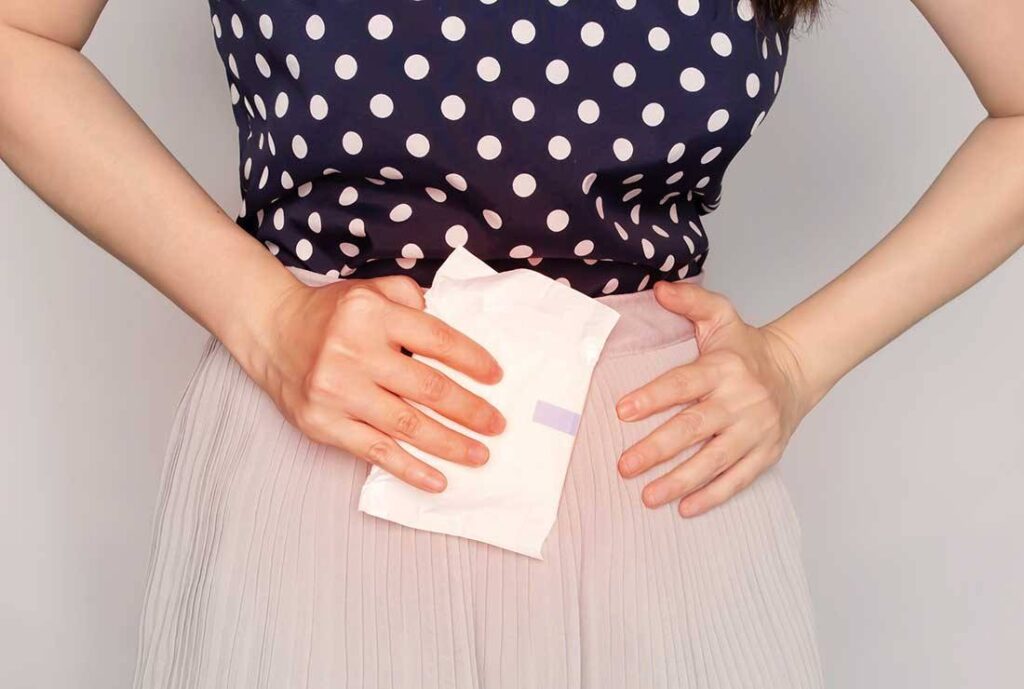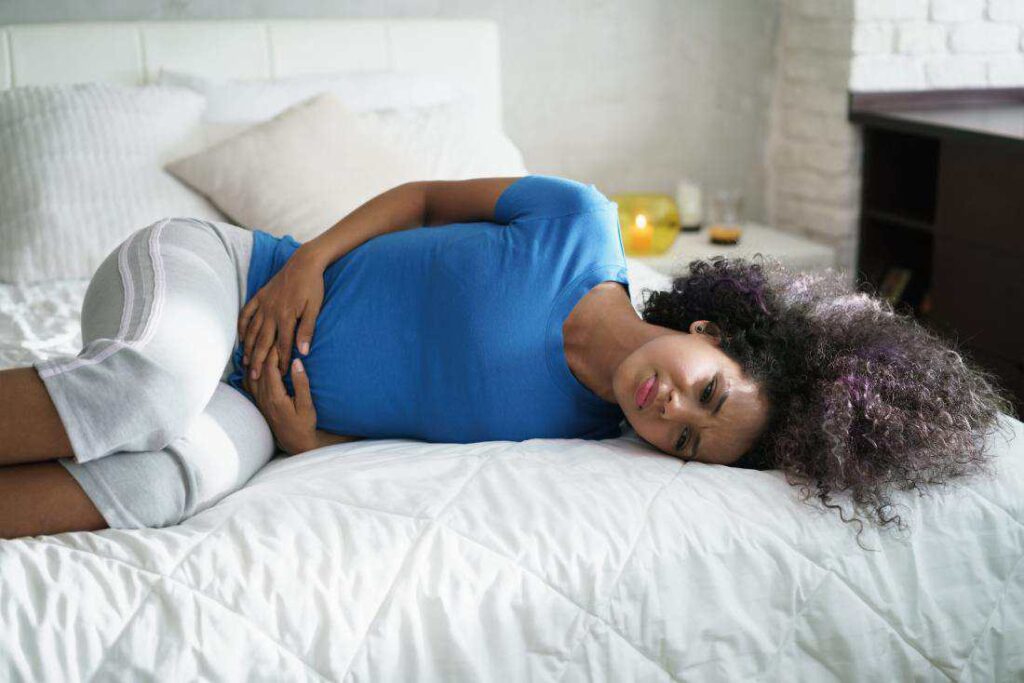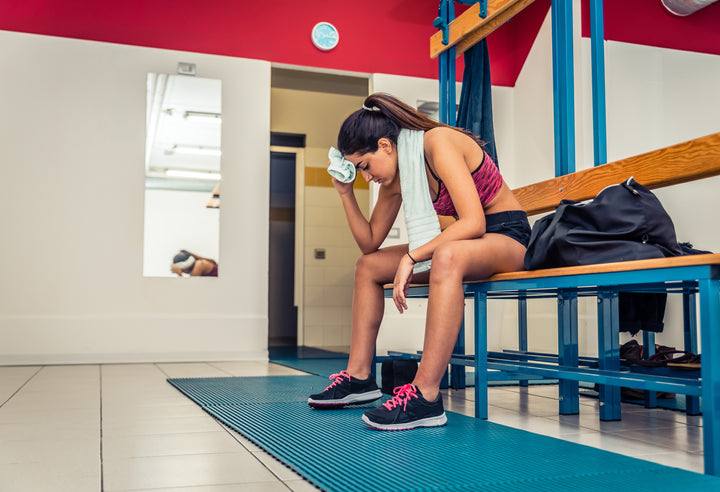Having vaginal bleeding after exercising? Stay Calm! How to stop breakthrough bleeding after exercise? This is a common occurrence faced by many women. Numerous factors underlie vaginal bleeding during or after exercise. And our experts offer this knowledge in the most useful manner.
If you are in pain or facing an urgent situation, we strongly advise seeking consultation with a clinician or physician at the earliest.
Types Of Bleeding After Exercise

Before digging deep into the answer of how to stop breakthrough bleeding after exercise? You have to know what are the different types of vaginal bleeding.
Here are the types…
Normal Menstrual Cycle
For individuals with menstruating reproductive systems, a standard menstrual cycle typically spans 21 to 35 days, with bleeding persisting for 2 to 7 days.
Hormones regulate the menstrual cycle, with the uterine lining thickening in anticipation of a potential pregnancy. In the absence of pregnancy, the uterine lining sheds, leading to menstrual bleeding.
Amenorrhea And Exercise
Some female athletes, particularly those engaged in intense physical training or high-level sports, may experience a condition termed exercise-induced amenorrhea.
This denotes the absence of menstruation for three or more consecutive menstrual cycles.
The precise mechanisms underlying exercise-induced amenorrhea remain partially understood, but it can also involve hormonal imbalances due to stress and energy availability.
When To Seek Medical Attention?

How to stop breakthrough bleeding after exercise and when to seek medical attention? Here are the symptoms when you have to seek advice from a healthcare professional.
Excessive Bleeding: If bleeding exceeds the limits of a typical menstrual period or continues for an extended duration,
Pain or discomfort: If you experience severe pain or discomfort concurrent with the bleeding,
Foul Odor or Discharge: If the bleeding is accompanied by an unpleasant odor or unusual discharge,
Persistent irregular bleeding: If you observe prolonged irregular bleeding over several cycles,
What Are The Prevention And Treatments?
To reduce the risk of exercise-induced amenorrhea due to irregular bleeding, it is vital to strike a balance between exercise, nutrition, and rest.
An adequate caloric diet and appropriate nutrition assume critical importance, as extreme caloric shortages can disrupt hormone levels. Consulting a healthcare provider or sports nutritionist can be instrumental for athletes in ensuring their nutritional requirements are met.
Types Of Vaginal Bleeding After Exercise

Diverse Manifestations of Vaginal Bleeding After Exercise Vaginal bleeding after exercise can manifest in various forms, and discerning these different types can aid individuals in ascertaining whether the bleeding is routine or suggestive of an underlying concern.
How to stop breakthrough bleeding after exercise? Unless you are not aware of types of vaginal bleeding. It will be tough to diagnose the symptoms. Presented below are the distinct forms of vaginal bleeding after exercise, discussed:
1. Prolonged Bleeding Or Spotting
Breakthrough bleeding, or spotting, involves light, sporadic bleeding transpiring between menstrual periods.
Post-exercise, hormonal fluctuations may occur, culminating in the shedding of a minute portion of the uterine lining and giving rise to spotting. Breakthrough bleeding is conventionally deemed routine and is frequently devoid of any cause for alarm.
2. Mid-Cycle Bleeding
Mid-cycle bleeding also recognized as intermenstrual bleeding, encompasses bleeding that arises between menstrual cycles, typically around the time of ovulation.
Exercise can, on occasion, precipitate hormonal shifts, potentially leading to mid-cycle bleeding in select individuals. While intermittent mid-cycle bleeding may be routine, persistent or severe instances necessitate medical evaluation.
3. Elevated Menstrual Flow
In specific scenarios, rigorous exercise may occasion an upsurge in blood flow during the menstrual period, resulting in a more copious flow than is customary.
After exercise, heightened menstrual flow may be more conspicuous and might necessitate additional safeguarding measures, such as an absorbent tampon or any menstrual pad.
4. Prolonged Menstrual Bleeding
Prolonged menstrual bleeding pertains the periods that extend beyond the typical duration of an individual’s menstrual cycle (usually 2 to 7 days). Exercise-induced hormonal shifts can sporadically lead to protracted menstruation in certain individuals.
5. Breakthrough Bleeding In Pregnancy
In the early stages of pregnancy, some women may encounter breakthrough bleeding, which can be mistaken for a light menstrual period.
Vigorous exercise might conceivably induce this type of bleeding during early pregnancy. However, it is imperative to exclude other potential causes of bleeding in pregnancy and seek medical counsel.
6. Painful Bleeding
Bleeding post-exercise may be accompanied by pelvic pain or discomfort in specific cases. Painful bleeding could be associated with conditions such as endometriosis or uterine fibroids.
7. Post-Menopausal Bleeding
Postmenopausal bleeding denotes vaginal bleeding transpiring after a person has undergone menopause, defined as the absence of menstrual periods for 12 successive months.
How to stop breakthrough bleeding after exercise even post-menopausal bleeding. It is anomalous and mandates immediate medical assessment to rule out serious conditions like cervical or uterine cancer.
Causes Of Vaginal Bleeding During Exercise

Underlying Causes of Vaginal Bleeding During Exercise Vaginal bleeding during exercise can stem from various causative factors, necessitating the discernment of whether it constitutes a routine or disconcerting event.
Below, I explain some of the likely causes of vaginal bleeding during exercise in complete detail:
1. Breakthrough Bleeding
Breakthrough bleeding denotes light spotting or bleeding occurring at unanticipated intervals during the menstrual cycle. It may transpire between periods or in the early stages of pregnancy for certain individuals.
Hormonal fluctuations can precipitate breakthrough bleeding. Intense exercise or physical activity can occasion transient shifts in hormone levels, which may incite this form of bleeding.
Breakthrough bleeding is generally not grounds for apprehension unless it assumes a persistent or severe character.
2. Uterine Irritation
Vigorous physical activity, particularly high-impact exercises like running or jumping, can subject the uterus to augmented pressure or friction.
This heightened pressure may induce irritation of the uterine lining, resulting in light bleeding or spotting. This category of bleeding is commonly of minimal magnitude and tends to resolve autonomously without necessitating medical intervention.
3. Hormonal Imbalances
Intense exercise or pronounced alterations in physical activity levels can exert an influence on hormone levels within the body.
Hormones, encompassing estrogen and progesterone, wield a pivotal role in orchestrating the menstrual cycle and sustaining the uterine lining. How to stop breakthrough bleeding after exercise when you have hormonal imbalances?
Disturbances in hormonal equilibrium can engender irregular menstrual cycles, encompassing mid-cycle bleeding concurrent with exercise.
4. Exercise-Induced Amenorrhea
Exercise-induced amenorrhea is characterized by the absence of menstruation for three or more successive menstrual cycles, attributable to rigorous physical training or participation in high-level sports.
While the precise mechanisms governing exercise-induced amenorrhea are not entirely elucidated. This may also involve hormonal imbalances linked to stress and energy availability.
Sustained amenorrhea may have implications for both bone health and reproductive well-being. Hence, it is imperative to address this issue under the aegis of a healthcare professional.
5. Basic Medical Conditions
In select instances, vaginal bleeding during exercise may be correlated with latent medical conditions affecting the reproductive system.
Conditions such as polycystic ovary syndrome (PCOS), uterine fibroids, endometriosis, or pelvic inflammatory disease (PID) can occasion irregular bleeding patterns, with exercise potentially exacerbating the symptoms.
6. Infections And injuries
In rare circumstances, vaginal bleeding during exercise may emanate from infections or injuries localized to the genital region.
Yeast Infections like infections or any sexually transmitted infections may engender inflammation and bleeding. Injuries sustained by the vaginal or pelvic area by trauma can similarly culminate in bleeding.
7. Normal Vaginal Bleeding During Training
The normal and common vaginal bleeding during exercise is typically characterized by faint spotting. Or a minor escalation in menstrual flow transpiring during or promptly after physical activity.
It is customarily considered a standard fluctuation of the menstrual cycle and does not occasion substantive concern. Below, I expound upon some salient points regarding normal vaginal bleeding during exercise.
8. Chronology And Incidence
Normal vaginal bleeding during exercise also indicates the phase of your menstrual cycle. But it is most frequently observed proximate to ovulation or during the mid-cycle. It is imperative to differentiate between spotting and authentic menstruation.
Spotting entails slight bleeding or modest quantities of blood, while menstruation encompasses a more sustained flow.
Different Factors Which You Can’t Ignore For Diagonis Vaginal Bleeding?

Each individual’s physiological response to exercise and hormonal changes is unique. How to stop breakthrough bleeding after exercise and how to find the reason behind it? Consulting a healthcare professional is the best course of action, as they can offer personalized guidance and address any underlying worries.
1. The Volume Of Bleeding
Ordinarily, normal vaginal bleeding during exercise is markedly slight and may necessitate only the utilization of a panty liner or thin pad. The bleeding ought not to attain a level of intensity that leads to saturation of a conventional pad or tampon within a brief span.
2. Duration
The duration of normal vaginal bleeding during exercise is commonly ephemeral. It may endure for a few hours to a day, typically resolving autonomously without medical intervention.
3. Associated Symptoms
In the majority of instances, typical bleeding during exercise is unaccompanied by notable pain and discomfort. Mild cramping can also be present, albeit of a generally non-severe nature.
4. Hormonal Influences
Hormonal oscillations, especially alterations in levels of estrogen and progesterone, can contribute to normal vaginal bleeding during exercise.
Exercise can transiently influence hormone levels, engendering fluctuations in menstrual flow.
5. Consistent Menstrual Cycle
Normal vaginal bleeding during exercise is more inclined to arise in individuals boasting regular menstrual cycles.
Those with irregular menstrual cycles or conditions like polycystic ovary syndrome (PCOS) may experience diverse patterns of bleeding, with exercise potentially exerting varied effects on their menstrual cycle.
6. Age And Life Stage
The manifestation of normal vaginal bleeding during exercise may diverge depending on age and life stage. Teenagers and young adults may undergo more pronounced fluctuations in their menstrual cycles due to hormonal shifts and irregular ovulation, making them susceptible to the influence of exercise.
Exercise can impact menstrual patterns in older individuals nearing menopause, potentially causing normal vaginal bleeding. It’s crucial to differentiate between abnormal bleeding and seeking medical attention if necessary.
Vaginal Bleeding During Exercise: Possible Medical Conditions

Vaginal bleeding during exercise can be triggered by various medical conditions affecting the reproductive system.
Such as voluminous bleeding, severe pain, prolonged irregular bleeding, foul odor, or abnormal discharge, which can lead to tampon saturation.
1. Polycystic Ovary Syndrome (PCOS)
PCOS stands for a hormonal disorder affecting the ovaries, culminating in the formation of numerous diminutive cysts. How to stop breakthrough bleeding after exercise when they have PCOS?
Women grappling with PCOS may undergo irregular menstrual cycles, encompassing prolonged or absent periods. Hormonal imbalances intrinsic to PCOS can incite breakthrough bleeding or spotting, which may be sparked or exacerbated by intense exercise.
2. Uterine Fibroids
Uterine fibroids are benign growths that materialize within or on the uterus. Depending on their location and dimensions, fibroids can precipitate abnormal bleeding, encompassing heavy or extended menstrual periods.
Exercise-induced irritation of the uterus could potentially give rise to bleeding in individuals harboring fibroids.
3. Endometriosis
Endometriosis constitutes a condition wherein the tissue conventionally lining the interior of the uterus (endometrium) takes root beyond the confines of the uterus.
Throughout the menstrual cycle, these extramural endometrial tissues can disintegrate, inducing internal bleeding. Intense physical activity might exacerbate both the pain and bleeding entailed by endometriosis.
4. Pelvic Inflammatory Disease (PID)
PID denotes an infection affecting the female reproductive organs, often traceable to sexually transmitted bacteria.
PID can lead to inflammation, scarring, and harm to the fallopian tubes, ovaries, and uterus. In select instances, PID may provoke irregular bleeding or bleeding concurrent with exercise.
5. Cervical Or Vaginal Infections
Infections localized to the cervix or vagina, such as yeast infections or bacterial vaginosis, can cause inflammation and irritation of the vaginal tissues. This irritation can culminate in bleeding, particularly during or after exercise.
6. Cervical Polyps
Cervical polyps represent minuscule, benign growths that may surface on the cervix. While typically benign, they may give rise to bleeding, especially during post-sexual intercourse or activities like exercise.
Bottomline

Guess you get the answer for how to stop breakthrough bleeding after exercise and when to get help from a healthcare professional. In rarefied instances, vaginal bleeding during physical activities might serve as an indicator of cervical or uterine cancer. Anomalous bleeding, particularly among post-menopausal women or those harboring risk factors, necessitates evaluation by a healthcare professional.
Also Read:
- Back Pain: Signs, Symptoms, Causes, Prevention
- Why Do Exercise Needs Vary Between Individuals?
- Enfamil Or Similac: Which Formula Is Best For My Baby?


